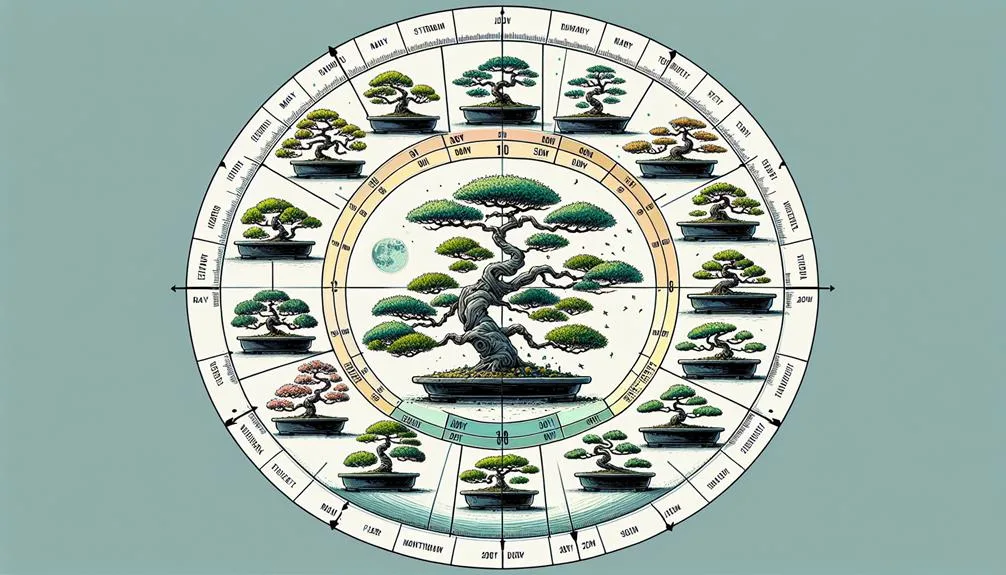The Bonsai Care Calendar aims to address the intricate art of caring for my bonsai tree. It provides a systematic plan for year-round maintenance and demands meticulousness and timeliness.
This essential tool navigates me through the distinctive care needs of each season, whether it involves nurturing my bonsai during the dormant period of winter, rejuvenating it in the crispness of spring, or gearing it up for the cold of autumn.
It also presents a comprehensive strategy for the frequent maintenance of both indoor and outdoor bonsai trees.
Although this guide offers an extensive overview, I must keep in mind that each bonsai tree is unique and may need modifications in its care.
To make sure my bonsai tree flourishes, understanding the specifics of its care and the importance of punctual task execution is crucial.
Key Takeaways for the Bonsai Care Calendar
- Bonsai care involves specific tasks for each season, including winter dormancy care, spring awakening tasks, summer maintenance, and autumn preparation.
- Year-round observations are important for monitoring the tree’s health, growth, and potential issues such as pests, diseases, and stress.
- Proper watering is crucial, with adjustments based on the season, well-draining soil to prevent root rot, thorough watering until drainage, and monitoring soil moisture levels.
- Fertilizing should be done with a balanced bonsai fertilizer, following the manufacturer’s instructions, and adjusting frequency based on the growing season. Pruning and repotting are also essential, with regular pruning, removal of dead or damaged branches, repotting every 1-2 years, and pruning the roots during repotting. Adequate protection from extreme temperatures, frost, and strong winds is necessary, as well as regular inspection for pests and diseases.
January – Winter Dormancy Care
In January, winter dormancy care is the focus for the bonsai . This phase entails routine maintenance to prevent parasite or fungus infestation, and careful monitoring of soil moisture levels. It is crucial to ensure that your bonsai remains healthy during the harsh weather conditions. For Outdoor Bonsai, it is particularly important to maintain a balance, as both excessive dryness and moisture can lead to root damage.
One key aspect of care for your bonsai during this period is repotting. This is the ideal time to clean the root ball and enhance the roots, especially for broadleaves and conifers. The success of this task directly influences the bonsai’s health in the subsequent reawakening phase in early spring.
As January transitions into late winter, continue with routine checks for signs of budding in broadleaves. Certain species may require cutting or pinching to control growth. These care tips, along with maintaining a vigilant eye for signs of new shoots and parasite infestation, form the essence of winter dormancy care.
This diligent attention in January sets the foundation for the flourishing growth of your bonsai in the coming seasons.
April – Spring Awakening Tasks

The ‘Spring Awakening Tasks‘ phase shifts in April as the chill of winter fades and the buds of spring begin to form. This is a crucial period for bonsai trees as they transition from dormancy to new growth. It’s a time to carefully monitor and adjust care routines to support the development of leaf buds and fine roots.
In early spring, water outdoor trees weekly or more frequently if they’re growing, while refraining from fertilizing unless buds start to grow. Indoor bonsai trees should also be watered weekly, with fertilization every two weeks at half strength if leaves are growing. This is also an ideal time for repotting with fresh soil.
Inspect broadleaves for signs of budding and control overly vigorous growth. Pinch buds on Japanese maples to induce smaller growth and promote a healthy growing season. As leaf buds reach and swell, repot and root trim bonsai trees. Prune in early spring to direct energy into desired branches and plan for future bonsai projects. Once frost threat has passed, move bonsai outside permanently for the season.
July – Summer Bonsai Maintenance
With the arrival of July, bonsai care transitions into ‘Summer Bonsai Maintenance‘, a period characterized by increased watering and misting, timely repotting, and careful pruning to ensure optimal growth and health of the trees. This time is crucial for managing the 35 or more varieties of bonsai trees you may have, each with their unique needs and requirements.
For outdoor bonsai specimens like pines, junipers, and yews, light pruning should be done to encourage new shoots and maintain a balanced structure. Indoor trees also need attention. Defoliation, repotting, and regular misting are necessary tasks. Always remember, new growth needs to be monitored closely.
Watering routines are paramount during July. Summer bonsai maintenance requires daily watering and misting because of the summer heat. Providing midday shade for deciduous bonsai is also essential to prevent leaf scorching. Meanwhile, vigorous trees may need defoliation to promote healthier and smaller leaves.
Lastly, planning for winter storage starts now. Prepare your bonsai by removing any remaining leaves, cleaning the tree, and applying an anti-bacterial solution. This early preparation ensures a smooth transition as the seasons change.
October – Autumn Bonsai Preparation
October ushers in the Autumn Bonsai Preparation requiring a strategic shift towards winter preparation and significant changes for bonsai care. As early autumn sets in, it’s the best time to move outdoor bonsai to a sunny area, to protect from wind and low temperatures. Watering should be reduced as the soil dries with the cooling days.
Deciduous trees, such as the Japanese maple, require particular attention during this period. Here are some key tasks for regular and deciduous bonsai:
- Regular Bonsai:
- Reduce watering
- Move to sunny area
- Prepare for winter storage
- Deciduous Trees:
- Protect from wind
- Prepare for winter by removing remaining leaves
- Clean and use an anti-bacterial solution
Certain species, especially tropical trees, should be moved indoors once temperatures dip into the mid and low 50s. As frost can strike unexpectedly, early preparation for winter storage is crucial.
With these steps, your bonsai can thrive through the autumn transition and emerge strong in the spring. Remember, bonsai mastery lies in understanding and responding to each season’s unique demands.
Ongoing – Year Round Observations
While the changing seasons demand specific care routines, the task of monitoring the bonsai tree’s health and growth is a year-round commitment. Regardless of the time of year, every two weeks, it’s essential to observe the tree closely for any signs of pests, diseases, or stress. This preventative measure allows you to address issues promptly, ensuring the tree’s health and longevity.
Throughout the year, be vigilant about maintaining optimal soil moisture levels. The watering frequency may need adjustments depending on the season, weather conditions, and the specific needs of your tree. Tropical trees, for instance, often require more frequent watering.
Monitor growth patterns three times a year. Note when buds start to appear, track leaf development, and monitor any unusual changes. This observation will provide valuable insight into the tree’s health and its response to your care routine.
Continuously assess the overall health and appearance of the tree. Pay attention to the color, texture, and resilience of the leaves. Regular observation and prompt action when issues arise will ensure your bonsai thrives, regardless of the season.
Frequently Asked Questions
What Is the One to Six Rule of Bonsai?
The one to six rule of bonsai is a guiding principle for bonsai aesthetics, dictating that the first branch should ideally be one-sixth the total height of the tree, contributing to balanced growth and harmony.
How Often Do You Have to Take Care of a Bonsai Tree?
Bonsai tree care, including repotting, pruning, leaf trimming, fertilization, winter protection, pest control, and indoor placement, is an ongoing process that requires regular attention, typically on a daily to weekly basis, depending on the season and tree’s needs.
What Is the Watering Schedule for Bonsai?
Watering techniques for bonsai depend on soil moisture, bonsai species, indoor vs outdoor environment, water quality, and seasonal variations. Overwatering can lead to harmful consequences, thus a balanced schedule based on these factors is crucial.
What Is the Timeline for a Bonsai Tree?
The timeline for a bonsai tree includes various stages such as beginnings, growth, and environmental fluctuations. Seasonal changes dictate the repotting timeline, pruning schedule, and fertilization frequency, all crucial for the tree’s health and longevity.




